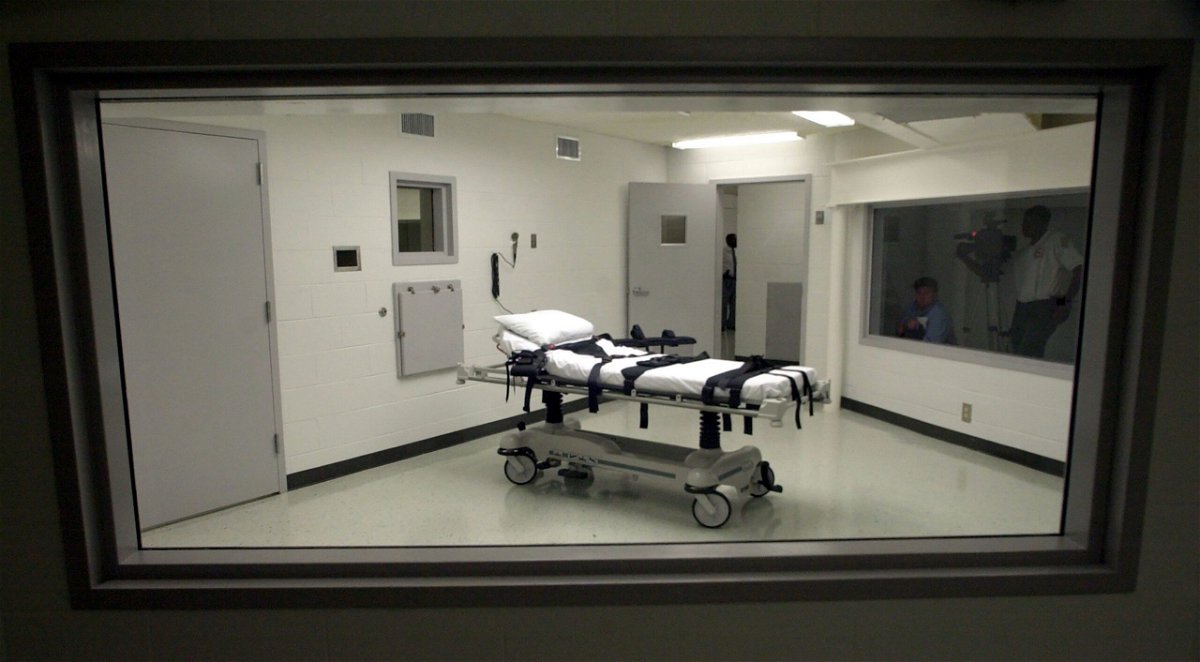An Alabama inmate was executed with nitrogen gas. How does it work?

Officials say Kenneth Smith's execution will likely take place Thursday evening. Pictured is Alabama's execution chamber at Holman Correctional Facility in Atmore
(CNN) — Alabama inmate Kenneth Smith was put to death Thursday night, marking the nation’s first known execution using nitrogen gas.
Smith, who was sentenced to death for his role in a 1988 murder for hire and already survived a botched execution attempt by lethal injection, was at the center of a heated debate over whether the execution method constitutes cruelty.
Smith’s lawyers made several eleventh-hour attempts to prevent the execution. A federal appeals court on Wednesday and the US Supreme Court on Wednesday and Thursday declined to halt it.
“Execution is a very specific kind of punishment, and no punishment, according to the US Constitution, can be carried out in a cruel fashion,” Dr. Joel Zivot, an associate professor of anesthesiology and surgery at Emory University, told CNN. “And so the only real question is: Is execution with nitrogen gas cruel?”
Why nitrogen gas?
Officials started using lethal injection to kill people on death row about 40 years ago, and it’s since become the most widely used execution method across the 27 states where capital punishment is legal.
Around 2009, the drugs used to carry out lethal injections became harder to access, and states began turning to alternative drugs – a shift that has been tied to a surge of complications with the procedure.
That’s what happened when Alabama first tried to execute Smith in November 2022, and officials were unable to set an intravenous line before the execution warrant expired.
Only three states – Alabama, Oklahoma and Mississippi – have approved the use of nitrogen gas for capital punishment, and experts say there is no real blueprint for the execution method. Alabama has published a protocol for the procedure, though it contains redactions the state says are meant to maintain security.
How does it work?
Alabama officials planned to use a mask to administer the nitrogen to Smith. Smith likely would have been strapped down when this occurred, Zivot said before the execution.
Nitrogen hypoxia would occur when a high concentration of the gas is inhaled, replacing oxygen in the body and causing death.
The process essentially disables the respiratory system, said Dr. Jonathan Groner, a professor of surgery at The Ohio State University College of Medicine.
Some officials say that a person would likely lose consciousness shortly into the procedure, making it more humane than other execution methods. However, doctors have said that they could not pinpoint if or when a person will lose consciousness when exposed to high concentrations of nitrogen gas.
On Thursday night, the execution process started at 7:53 p.m. CT, and a physician pronounced Smith dead at 8:25 p.m. CT, Alabama Department of Corrections Commissioner John Hamm said. Nitrogen flowed for about 15 minutes during that time, and “nothing … out of the ordinary” happened compared to “what we were expecting,” Hamm said.
According to witnesses from the news media, Smith “appeared conscious for several minutes into the execution.”
“For about two minutes following that, Kenneth Smith shook and writhed … on a gurney,” the media witnesses said in a joint report. “That was followed by several minutes of deep breaths on the gurney.”
“Following that, his breath slowed until it was no longer perceptible for media witnesses,” the journalists said in their joint report.
Asked whether the shaking and writhing was evidence that Smith suffered, Hamm said: “(It) appeared that, one, Smith was holding his breath has long as he could.”
“And then there’s also information out there that he struggled against his restrains a little but, but there’s some involuntary movement and some agonal breathing, so that was all expected and is in the side effects that we’ve seen or researched on nitrogen hypoxia,” Hamm said. Agonal breathing is usually described as a kind of gasping seen in people who are dying.
Is the procedure painful?
This month, United Nations experts raised the alarm that Smith’s execution could constitute torture, saying in a news release, “We are concerned that nitrogen hypoxia would result in a painful and humiliating death.”
While doctors couldn’t say definitely, ahead of the execution, what would happen to Smith, the possibilities left many concerned.
If a mask is not secured tightly enough, oxygen could leak in, prolonging the death, experts say.
“When we put 100% non-rebreather face masks on our patients, they never get 100%, because there’s some leakage,” Groner said before Smith’s execution. “I feel pretty confident that he’s not going to just take a deep breath and go to sleep. I think that’s unlikely.”
Doctors say the lack of oxygen could lead to seizures, which have been observed in patients experiencing hypoxia.
There’s also a possibility that a person being executed with this method could vomit into the mask, which could cause choking or asphyxiation if inhaled into the lungs.
The Department of Corrections altered Smith’s last meal schedule after concerns were raised that he had been “vomiting repeatedly.”
Even if a person is fasting, they can still vomit water or stomach fluids, experts say. If stomach acid is aspirated, it could burn the lungs, Zivot noted.
The stress, anxiety or flat-out fear that a person might feel before execution shouldn’t be ruled out, Groner said.
“When we have an operation and someone’s totally terrified, they actually respond differently to anesthetics, so a lot of times we’ll give them a sedative before we even go into the operating room,” he said before Smith’s execution. “There’s no talk anywhere of giving (Smith) anything to relax him.”
With most lethal injections, a person is first given an anesthetic to render them unconscious.
Increased stress has been linked to heart attacks and other medical events.
In a botched 2014 execution, Oklahoma death row inmate Clayton Lockett was declared dead of a heart attack more than an hour after being strapped to a gurney for an attempted lethal injection.
Officials say what happened in the Alabama execution chamber Thursday night could set a precedent for other death row prisoners in the state and beyond.
If the procedure did not kill Smith, complications could have left him injured or with serious brain damage, experts said before the execution.
“If they produce a corpse, then the states that want to do this will start doing it,” said Zivot.
The-CNN-Wire
™ & © 2024 Cable News Network, Inc., a Warner Bros. Discovery Company. All rights reserved.
CNN’s Dakin Andone contributed to this report.


